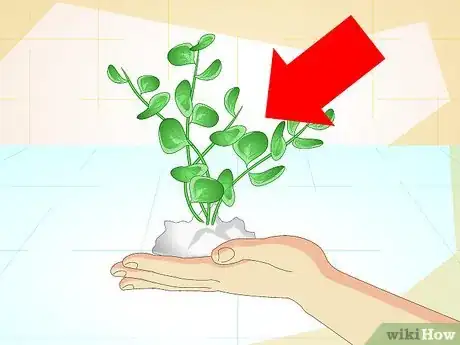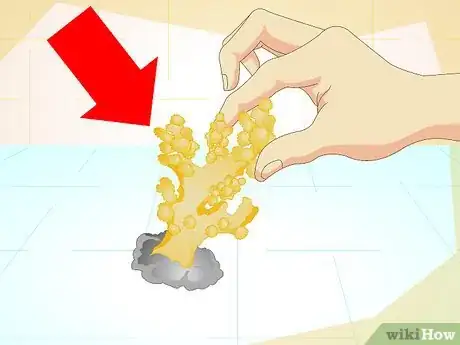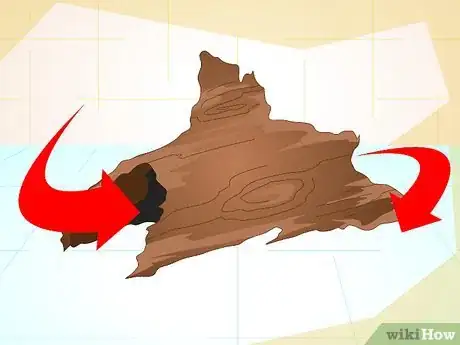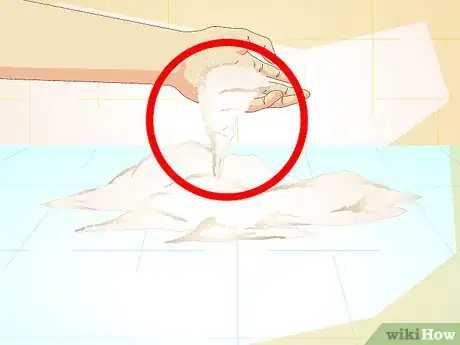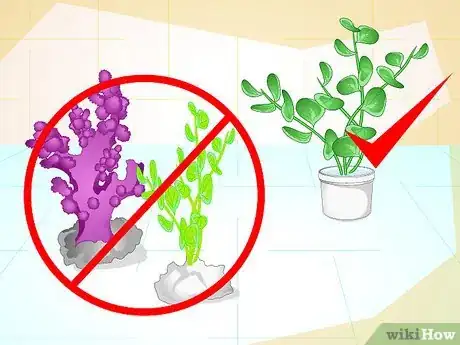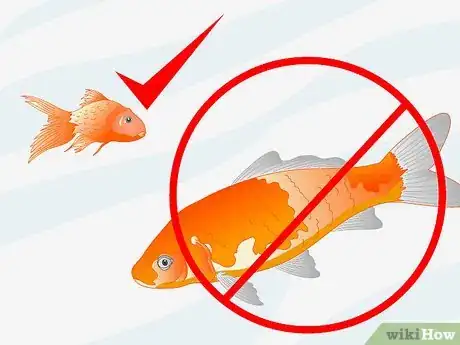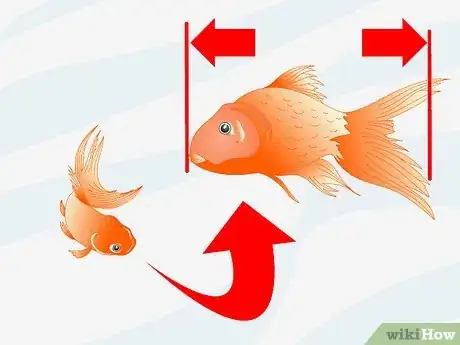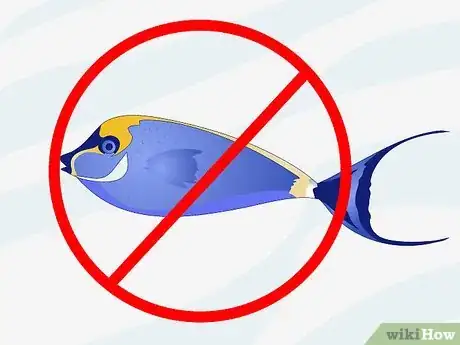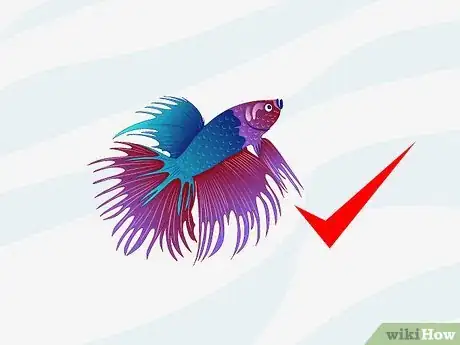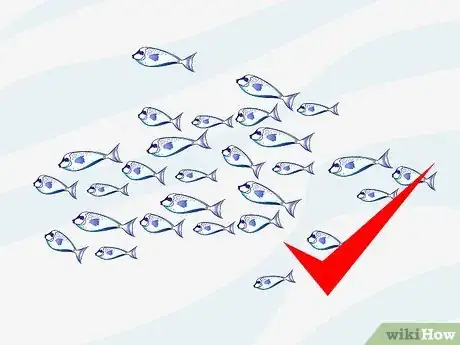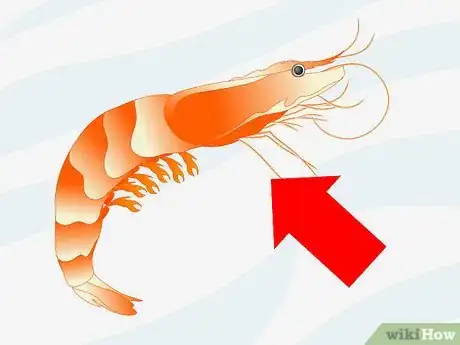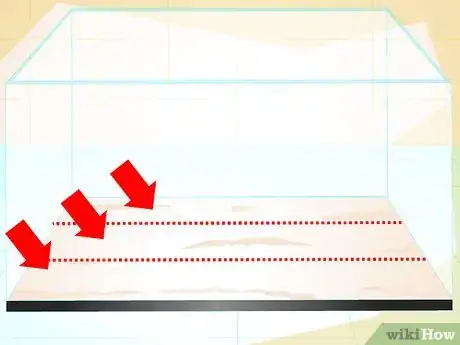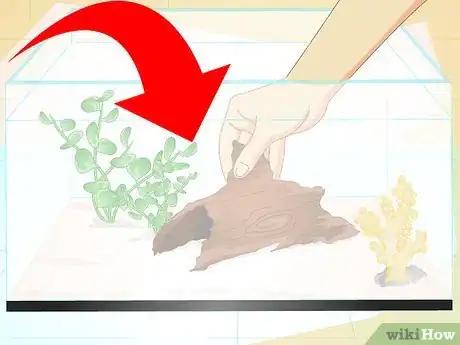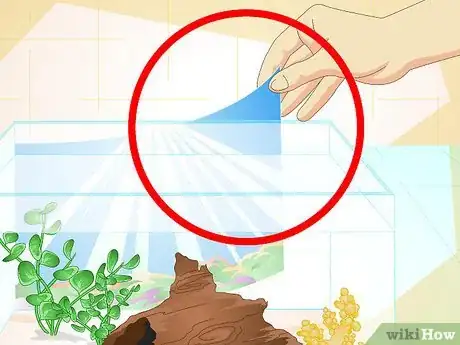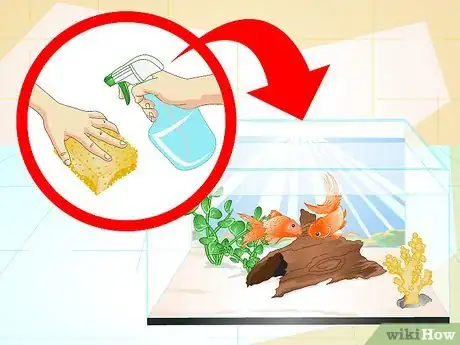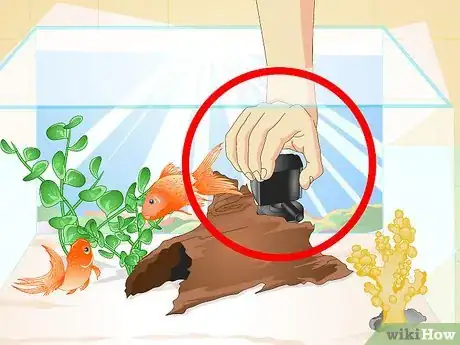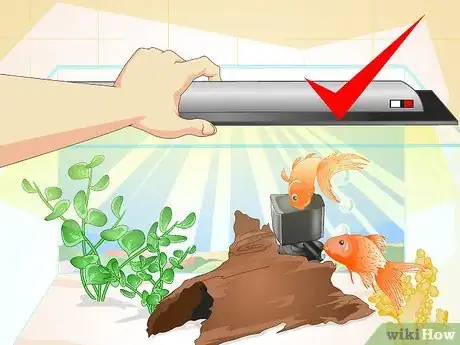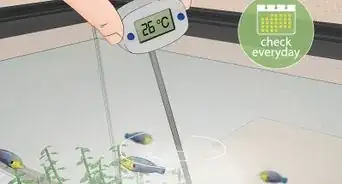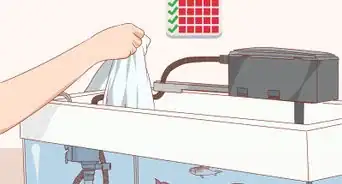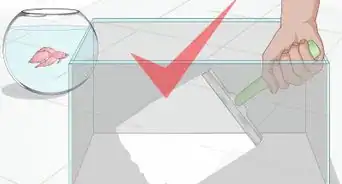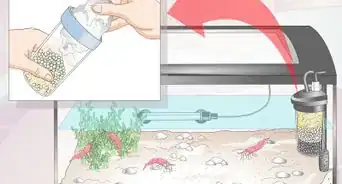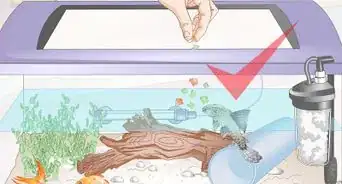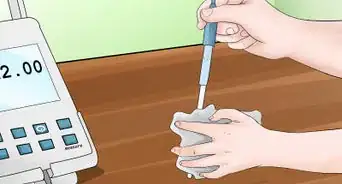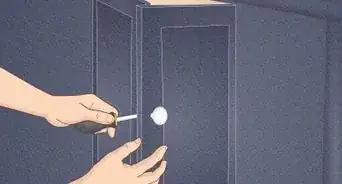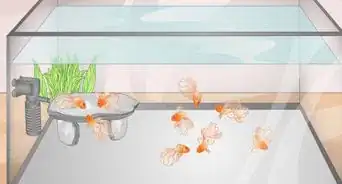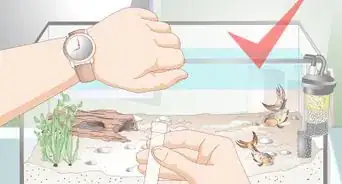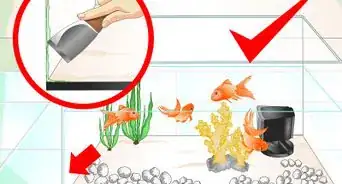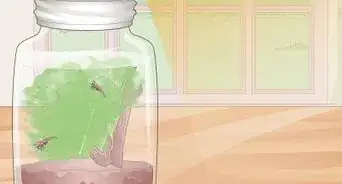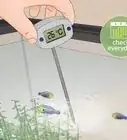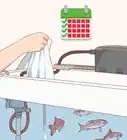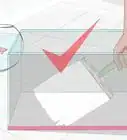This article was co-authored by Aaron Bernard. Aaron Bernard is an Aquarium Specialist and the Owner of Limited Edition Corals in Phoenix, Arizona. With over ten years of experience, Aaron specializes in aquarium maintenance, custom design, manufacture, installation, and moving. Aaron holds a BS in Biochemistry from Arizona State University, where he studied the effects of climate change on coral reefs and began to propagate his corals.
There are 10 references cited in this article, which can be found at the bottom of the page.
This article has been viewed 238,154 times.
Next to 2.5 gallon (9.46 L) aquariums, 5 gallon aquariums are the second smallest in the fish keeping world. They do not have much space for a lot of decorations or fish, but this does not mean that they have to look boring and empty. With the right decorations, fish, and placement, it is possible to make even the smallest aquarium look interesting.
Steps
Choosing the Right Decorations
-
1Choose smaller decorations. Many decorations are designed with larger aquariums in mind, and will make your aquarium appear cramped, cluttered, and smaller than it actually is. When choosing decorations, pick out the smallest ones available, so that they will be proportionate to your aquarium.
-
2Consider natural decorations instead factory-made ones. It is much easier to find a piece of driftwood or a couple of rocks that are the right size for your aquarium than a pre-made decoration. Natural pieces often have organic, irregular, and random shapes, all of which will make your aquarium appear more interesting. Be sure to thoroughly rinse any natural decoration before putting it into your aquarium, even if you bought it in a store. Most items found in nature will contain harmful bacteria, and store-bought items are often covered in dust.
- Do not use soap or tap water to clean your decorations; instead, rinse them using some of the aquarium water, then put them in a separate (isolation) tank for a few weeks. This will allow the piece to get the good' bacteria and make it safe for your fish. Afterwards, you may add the piece to your aquarium.[1]
Advertisement -
3Match the decorations to your fishes' behavior. When designing your aquarium, try to keep your fishes' behavior in mind.[2] Some fish species are timid and need plenty of hiding places in order to feel comfortable, while other types of fish are very active and need lots of room to swim in; decorations would only get in their way. Here are some examples:
- If you have a timid fish species, consider adding some decorations with holes in them, such as vases, rocks, and logs for nice looking hiding spaces.
- If you have more active fish species, avoid crowding your tank with large, bulky items. Instead, consider filling your tank with smaller decorations or plants; the fish will be able to swim around the plants.
- Regardless of fish type, try to include a few decorations. Decorations are very important, as they will give your fish places to hide in when they feel stressed or unhappy.[3]
-
4Try using real plants instead of fake ones. Not only do real plants look much better, but they are also great at maintaining the water quality by filtering out toxins and waste. When buying plants for your tank, be sure to buy ones labeled for fish tanks; some plants can be toxic to fish. You can purchase aquarium plants in the fish department of more pet stores, and in many fish tank stores. Here are some suggestions:[4] [5]
- Amazon Sword has bright green, blade-like leaves.
- Amazon Frogbit is a floating plant.
- Java Fern has a similar shape to the Amazon Sword, but more delicate and textured leaves.
- Vallisneria is a short, grass-like plant. These would loke great towards the front of the tank.
- Anubias may develop a lily-like flower if allowed to grow past the water level.
- Anacharis is a long, thin, flexible plant, and would look great planted towards the back.
-
5Choose fine-grained gravel or sand. Not only will it look more proportionate than bulky gravel or rocks, but it may also make the fish feel more at home and comfortable. Try to avoid getting anything that is too rocky. Five gallon tanks are small and get dirty quickly; gravel and stones trap debris, which makes them difficult to clean. Here are some options:[6]
- Gravel comes in many different colors and sizes. Look for something that is small-grained and smooth. Natural colors might look better in a small tank than bright, un-natural colors.
- Sand is a great option for small tanks. Look for a medium-grained sand, such river sand, and avoid fine-grained "play sand."
- Marbles, rocks, and larger stones may look pretty, but they are best saved for decorations. Instead, consider filling the bottom of your tank with fine-grained gravel or medium-grained sand first, and then dropping a few aquarium marbles on top.
- Keep your plants healthy by adding nutrient tabs under the sand or gravel; this will give your plants extra nutrients (such as iron) that they won't get from the water alone.[7] Most aquarium plants will do just fine in ordinary aquarium sand or gavel, however, and do not need special soil like house plants do. You can find nutrient tabs for aquatic plants in the fish department of most pet stores.
-
6Avoid anything that is too brightly-colored and go for natural colors instead. Neon-colored gravel, plastic decorations, and fake plants tend to look better in larger tanks than in smaller ones. Anything that is too brightly colored will also clash with your fish, making the already-small tank appear cluttered and messy. Instead, consider creating a more natural environment by using brown-colored gravel or sand, pieces of driftwood or rock, and some real plants. The natural colors will contrast with your brightly-colored fish, helping them to stand out more.
Choosing the Right Fish
-
1Know what fish to get and what fish to avoid. Certain types of fish will do better than other types of fish in a small tank.[8] This section will give you suggestions as to what type of fish you should consider and what type of fish you should avoid.
-
2Know how big the fish will get. Most fish sold in stores are very young and will grow much larger (such as gold fish, plecos, and angel fish). Just because a fish is small when you buy it does not mean it will stay small. Your new fish may quickly outgrow its tank within a few months. A large fish should not be kept in such a small tank. Not only will the fish be unhappy, but it won't be very healthy.
-
3Avoid large fish and get smaller fish instead. Not only will large fish make your tank appear crowded, but they will produce more waste than the tank can handle. Smaller fish, on the other hand, will appear more proportionate; you can also keep several fish in a small tank provided that they are small enough. Here are some fish that you should definitely avoid, and why:
- Anything from the Cichlid family, including Dwarf Cichlids. They will grow large and need more room to swim than a five-gallon tank can offer.
- Any Corys larger than 1.5 inches (4 centimeters) are too big to be comfortable in small conditions like this.
- Plecos and Loaches will not fit in a five-gallon tank once they reach full size.
- Other large fish, such as: Arowanas, Knifefish, Elephant Nose, and Eels.
- Rainbowfish are very active and need to be kept in groups. Even the smallest ones get too big for a small tank.
- Anything from the cyprinid family, including Goldfish, Carps, Danios, Freshwater Sharks, Chinese algae eaters, some Barbs, and Rasboras.
-
4Stay clear from fish that produce a lot of waste. A five-gallon tank is small, which means that waste will build up a lot quicker. Some fish (most notably goldfish) will produce waste a lot quicker and lower the quality of the water.
-
5Skip the very active fish. Some fish are very active and need a lot of space to swim. A five-gallon tank does not have a lot of room to swim, even for very small fish. Peaceful and less active fish species are the most suitable for small tanks.
- If you want to get some more active fish, then consider getting a long tank as opposed to a tall one; this will give your fish more swimming space.
-
6Consider getting a betta fish. Although both males and females are brightly colored, the males tend to have longer, flowing fins. They are solitary fish however, and do not fare well with other companion fish. Bettas can be very aggressive and territorial, leading them to bully other fish. Their fins are also delicate, and can be tempting for other fish to nibble on.[9]
- Bettas are also known as Siamese Fighting Fish for a reason. Do NOT keep more than one betta in a tank. They will fight and kill each other.
-
7Consider getting a school of small fish. Certain types of fish are happier if they are kept in groups of five to seven. When choosing a school of fish, look for something that is no larger than 1.2 inches (3 centimeters), and make sure that they are all the same species. Here are some suggestions:
- Neon tetra or green neon tetras. Both are small and colorful. Keep in mind that most tetras are fast-moving fish and will be happier in a larger tank.
- Cherry Barbs are small, red-colored fish with pale-colored bellies.[10]
- White Cloud Mountain Minnows are pale gold in color with short, red or orange-colored tails.[11]
- Least Killifish are pale yellow in color and do best in groups composed of one male and two females.[12]
- Pygmy and Dwarf Corys are small, silver fisher with a black stripe.
-
8Think about getting some cleaning fish or shrimp. Adding just one or two of these little guys can help keep your tank looking clean. They can also add some interest to the bottom area of your tank, which is where they like to live. Here are some options for you:
- A silver and black Otocinclus would be a great addition to a small tank, they are bottom feeders, so they will help keep the tank clean.
- A couple of Cherry Shrimp can be a wonderful addition to any tank, just be sure to give them plenty of hiding places in case the other fish try to bully them.[13] Shrimp are bottom feeders and can help your tank stay cleaner.
Setting Things Up
-
1Divide your tank into a foreground, middle ground, and background. This will make your aquarium appear more organized instead of cluttered. It will also help guide the eye around. Lastly, it will also add depth to your aquarium, making it appear larger than it actually here.
- Place smaller decorations, such as decorative marbles and stones towards the front of the aquarium.
- Place larger decorations, such as rocks and pieces of driftwood, towards the middle of the aquarium.
- Longer and thinner items, such as plants, should be placed towards the very back of the aquarium.
-
2Arrange decorations according to the shape of your aquarium. Most small aquariums come in two different shapes: a long rectangle and a tall cube or hexagon. This will determine whether you use long and wide decorations or tall and thin decorations. Here are some ideas on how you can work with the shape of your aquarium:
- For rectangular aquariums: This is your standard tank; it is wider than it is tall. Because of this, very tall decorations may not look very pleasing; instead, try using some wider decorations, such as logs and branches. Lay these down on their sides and add a few rocks. Make sure that none of your decorations are more than two-thirds the height of your tank. Don't forget to add a few plants towards the back.
- For tall cubes and hexagons: Because your tank is taller than it is wide, you won't have much room to spread out, so you will have to build upwards. Place your largest decoration, such as a large rock or piece of driftwood, towards the middle or back of the tank. Arrange a few small rocks in front of the central pieces, and add a few tall and slender plants in the back. Make sure that your decorations go no more than two-thirds past your tank's height.
-
3Add a background. Aquarium backgrounds are usually sold in rolls, and you can find them in most pet stores in the fish department as well as in most fish tank stores. You can purchase a solid-colored background, a patterned one, or even depicting a nature scene. Once you have chosen your background, trim it so that it fits your aquarium, and tape it to the back wall from the outside.[14]
- Consider buying a natural-looking one depicting logs, rocks, and underwater plants. Not only will this match the decor of your aquarium, but it will make it look larger.
-
4Design your tank with cleaning in mind. All aquariums need to be cleaned every once in a while, and the smaller a tank is, the more often it will need to be cleaned. For heavy algae buildups, you may even have to take everything out of your tank for a deep scrubbing. If cleaning your tank sounds like a hassle, consider a simpler setup instead of a complex one.[15] Try using one large decoration as your focal point, a few plants, and a few smaller pieces; these will be much easier to take out than a bunch of smaller items and a ton of plants.
-
5Try getting a smaller pump and filter and hiding it. Filters and pumps aren't very interesting to look at, but they are important for your tank. Try placing yours in the back corner of the tank, and placing a few tall plants in front of it.
-
6Consider getting a light for your tank. While fish do not need anything more than the natural light in your room, an electrical light above their tank can certainly make them appear more colorful. Some aquarium kits already come with a light, but it is also possible to purchase a special lid for your tank with a light attached to it. You do not need to leave the light on all the time; generally, a few hours a day is fine. Be sure to ask the store employee how much light your plants and fish should get, as each species has different requirements.
Expert Q&A
Did you know you can get expert answers for this article?
Unlock expert answers by supporting wikiHow
-
QuestionHow much will a full 5-gallon tank weigh?
 Aaron BernardAaron Bernard is an Aquarium Specialist and the Owner of Limited Edition Corals in Phoenix, Arizona. With over ten years of experience, Aaron specializes in aquarium maintenance, custom design, manufacture, installation, and moving. Aaron holds a BS in Biochemistry from Arizona State University, where he studied the effects of climate change on coral reefs and began to propagate his corals.
Aaron BernardAaron Bernard is an Aquarium Specialist and the Owner of Limited Edition Corals in Phoenix, Arizona. With over ten years of experience, Aaron specializes in aquarium maintenance, custom design, manufacture, installation, and moving. Aaron holds a BS in Biochemistry from Arizona State University, where he studied the effects of climate change on coral reefs and began to propagate his corals.
Fish & Aquarium Specialist
-
QuestionHow do I know if my fish will be happy in a 5 gallon tank?
 Aaron BernardAaron Bernard is an Aquarium Specialist and the Owner of Limited Edition Corals in Phoenix, Arizona. With over ten years of experience, Aaron specializes in aquarium maintenance, custom design, manufacture, installation, and moving. Aaron holds a BS in Biochemistry from Arizona State University, where he studied the effects of climate change on coral reefs and began to propagate his corals.
Aaron BernardAaron Bernard is an Aquarium Specialist and the Owner of Limited Edition Corals in Phoenix, Arizona. With over ten years of experience, Aaron specializes in aquarium maintenance, custom design, manufacture, installation, and moving. Aaron holds a BS in Biochemistry from Arizona State University, where he studied the effects of climate change on coral reefs and began to propagate his corals.
Fish & Aquarium Specialist
-
QuestionIs a 5 gallon fish tank too small?
 Aaron BernardAaron Bernard is an Aquarium Specialist and the Owner of Limited Edition Corals in Phoenix, Arizona. With over ten years of experience, Aaron specializes in aquarium maintenance, custom design, manufacture, installation, and moving. Aaron holds a BS in Biochemistry from Arizona State University, where he studied the effects of climate change on coral reefs and began to propagate his corals.
Aaron BernardAaron Bernard is an Aquarium Specialist and the Owner of Limited Edition Corals in Phoenix, Arizona. With over ten years of experience, Aaron specializes in aquarium maintenance, custom design, manufacture, installation, and moving. Aaron holds a BS in Biochemistry from Arizona State University, where he studied the effects of climate change on coral reefs and began to propagate his corals.
Fish & Aquarium Specialist
Warnings
- Don't overstock the tank, it is very harmful to the fish, not to mention the heavy maintenance it requires.⧼thumbs_response⧽
- Use caution when mixing different species of fish. Some types of fish don't get along with others, and other types (such as Bettas) should be kept alone.⧼thumbs_response⧽
- Don't keep fishes that grow very big like koi, goldfish etc. in a 5-gallon tank.⧼thumbs_response⧽
- Don't put goldfish in a 5-gallon aquarium, it is way too small and can result in stunting the fish's growth, unhealthy life, and early death.⧼thumbs_response⧽
- Never use soap or tap water to rinse your decorations. Instead, siphon out some of the tank water, and use that to rinse your decorations.[16]⧼thumbs_response⧽
References
- ↑ Fish Lore, Aquascape Aquarium Design Ideas
- ↑ Fish Lore, Tropical Fish Tips
- ↑ Aaron Bernard. Fish & Aquarium Specialist. Expert Interview. 17 July 2020.
- ↑ Fish Lore, Freshwater Aquarium Plants
- ↑ Aquariadise, 8 Easy Aquarium Plants
- ↑ Aquariadise, Choosing an Aquarium Substrate
- ↑ Fish Lore, Freshwater Aquarium Plants
- ↑ Aaron Bernard. Fish & Aquarium Specialist. Expert Interview. 17 July 2020.
- ↑ Aaron Bernard. Fish & Aquarium Specialist. Expert Interview. 17 July 2020.
- ↑ Fish Lore, Cherry Barb
- ↑ Fish Lore, White Cloud Mountain Minnow
- ↑ Aquariadise, Nano Fish for Small Tanks
- ↑ Aquariadise, 7 Easy Aquarium Invertebrates
- ↑ Aaron Bernard. Fish & Aquarium Specialist. Expert Interview. 17 July 2020.
- ↑ Fish Lore, Aquascape Aquarium Design Ideas
- ↑ Fish Lore, Tropical Fish Tips
About This Article
While you might not have a lot of space in a 5-gallon aquarium, you can make it interesting by choosing the right decor. Opt for the smallest plants and decorations you can find so they don’t overwhelm your tank, and consider using real plants, since they’ll help filter the water. Also, since you’ll need to make the most out of whatever you include in the aquarium, look for pieces that will serve a dual purpose, like providing a hiding spot if you have shy fish. Keep reading to learn how to choose fish for your 5-gallon aquarium!
